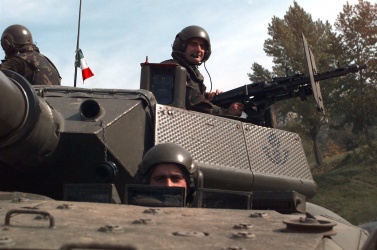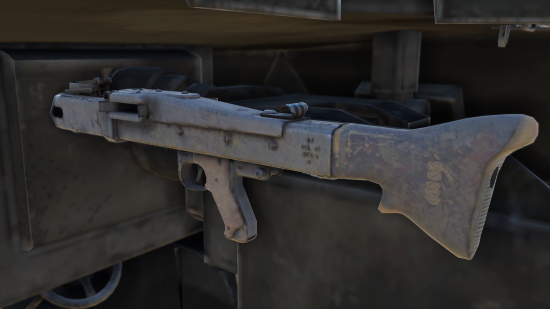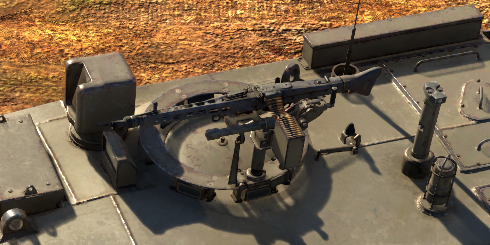Beretta MG42/59 (7.62 mm)
Contents
Description
Write an introduction to the article in 2-3 small paragraphs. Briefly tell us about the history of the development and combat using the weaponry and also about its features. Compile a list of air, ground, or naval vehicles that feature this weapon system in the game.
Vehicles equipped with this weapon
| Vehicles equipped with this weapon | |
|---|---|
| Light tanks | AUBL/74 · AUBL/74 HVG |
| Centauro I 105 · Centauro I 105 R · Centauro I 120 | |
| Dardo · VCC-80/30 · VCC-80/60 | |
| VBC (PT2) | |
| Medium tanks | Ariete (P) · Ariete · Ariete PSO |
| ▄Leopard 1A5 | |
General info
Tell us about the tactical and technical characteristics of the cannon or machine gun.
Available ammunition
- Default: AP · T
| Penetration statistics | ||||||
|---|---|---|---|---|---|---|
| Belt | Penetration @ 0° Angle of Attack (mm) | |||||
| 10 m | 100 m | 500 m | 1,000 m | 1,500 m | 2,000 m | |
| Default | 10 | 9 | 7 | 4 | 0 | 0 |
Comparison with analogues
Give a comparative description of cannons/machine guns that have firepower equal to this weapon.
Usage in battles
Describe the cannon/machine gun in the game - its distinctive features, tactics of usage against notable opponents. Please don't write a "guide" - do not impose a single point of view, but give the reader food for thought.
Pros and cons
Summarise and briefly evaluate the weaponry in terms of its characteristics and combat effectiveness. Mark pros and cons as a list.
Pros:
Cons:
History
The German MG42 machine gun's characteristics of a high rate of fire, quick-change barrel system, roller-locked mechanism, and cheap stamped construction made it an attractive weapon for analysis in the post World War II environment.[1] The large surplus of weapons from the defeated Nazi Germany's stockpiles left many weapons available for the taking, which saw the MG42 and MG34 see use in far reaches of the globe.[2] When time came to re-arm in the Cold War period, German Bundeswehr requested the MG42 to take the stand once more as the German's universal machine gun. However, due to the destroyed documentation to produce the weapon, Rheinmetall reverse-engineered existing MG42s and, with modifications to use the standardized 7.62x51 mm NATO rounds, issued the weapon as MG1 in 1959. A modification of the MG1A2 variant with heavier bolt for a lower firing rate and ability to feed from the United States' M13 belt link led to the now prominent MG3 machine gun, which began to see use in 1963.[3] Rheinmetall's machine guns would see use in many countries across the world eager for their hand on a modern universal machine gun.

| Rheinmetall marketed their MG1 machine gun commercially as the MG42/59, this is not to be confused with the Italian license-produced version.[3] |
Italy, during the post-war period, were also interested in a universal machine gun. This led to the Italians having Beretta license-produce the MG3 as the MG42/59 machine gun. The Italians, keeping with the weapon's nature as a universal machine gun, used the MG42/59 in an infantry, armoured, aircraft, and naval role for its service. Although recently the Italian army had made considerations to change over to the Belgium FN Minimi as their next squad automatic weapon, the Italian company Stabilimento Militare Armi Leggere Terni (SMALT) had offered a kit to convert existing MG42/59 machine guns to chamber the 5.56x45 mm NATO round for the role.[4]
Media
- Images
See also
- MG34 (7.92 mm) - The machine gun before the creation of the MG42.
- MG42 (7.92 mm) - The original machine gun that used the 7.92×57 mm Mauser round.
- MG3A1 (7.62 mm) - Post-war modernization for the 7.62×51 mm NATO round.
- Ksp 94 (7.62 mm) - Swedish variant.
External links
References
- Citations
- Bibliography
- McNab, Chris. MG 34 and MG 42 Machine Guns. Osprey Publishing Ltd., 2012.
| Tank machine guns | |
|---|---|
| USA | |
| 7.62 mm | M37 · M60D · M73 · M240 · M1919A4 · Mk.52 |
| 12.7 mm | FN M3P · M2HB · M80 · M85 |
| Germany | |
| 5.56 mm | MG4 |
| 7.62 mm | C6 · MG3A1 |
| 7.92 mm | MG13 Dreyse · MG34 · MG37(t) · MG42 |
| 12.7 mm | S.MG.50 |
| USSR | |
| 7.62 mm | DT · PKMB · PKT · PKTM · RP-46 · SGMT |
| 12.7 mm | DK · DShK · 6P49 · NSVT |
| 14.5 mm | KPVT |
| Britain | |
| 7.62 mm | Browning MG4 · L3A1 · L8A1 · L8A2 · L37A1 · L37A2 · L94A1 |
| 7.7 mm | Vickers |
| 7.92 mm | BESA |
| 12.7 mm | L21A1 |
| Japan | |
| 6.5 mm | Type 91 |
| 7.62 mm | Type 74 |
| 7.7 mm | Type 97 |
| 12.7 mm | Type 60 (B) |
| China | |
| 5.8 mm | QJT |
| 7.62 mm | Type 55 · Type 59 · Type 86 |
| 12.7 mm | QJC88A · Type 54 |
| 14.5 mm | QJG02 |
| Italy | |
| 7.62 mm | Beretta MG42/59 · FN MAG 60-40 |
| 8 mm | 34/40M · Breda Mod. 38 |
| 13.2 mm | Breda Model 31 |
| France | |
| 7.5 mm | AAT-52 · MAC 31 |
| 7.62 mm | A-A-F1N |
| 8 mm | Hotchkiss Mle 1914 |
| Sweden | |
| 6.5 mm | ksp m/14-29 |
| 7.62 mm | ksp 39 C · ksp 58 · ksp 94 |
| 8 mm | ksp m/36 · ksp m/39B |
| 12.7 mm | ksp 88 |





